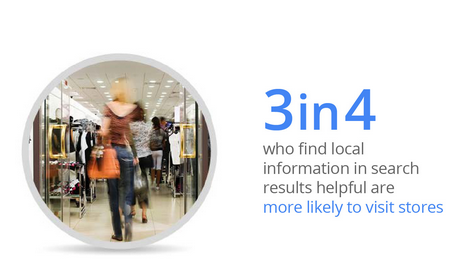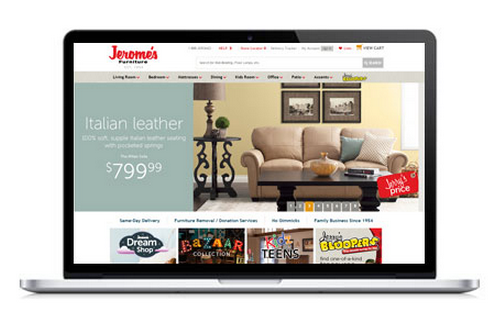Best Omni-Channel Retail Practices For Holistic Marketing in 2015

Omni-Channel practices are essential for a quality shopping experience in 2015. If shoppers notice a disconnect between your online and in-store presence, they could abandon your product or website all together and look to competitors for other options.
Although omni-channel integration may seem overwhelming at first, CPC clients like Jerome’s Furniture have successfully implemented quality tracking analytics and tools to streamline and improve the shopper’s journey.
Savvy consumers want the best product for the best price and they’re willing to check out in-store inventory in addition to online sales to find it.
Leading retailers are making sure anyone who shops online feels just as valued as anyone who shops in-store.
Both customers are valuable and both channels should be integrated and streamlined to ensure maximum buying potential and customer loyalty across all platforms.
1. Who is my target audience?
Before you can target your market, retailers should have a solid understanding of who their audience is, what they like and how they shop. Without this data – retailers run the risk of missing their niche market completely.
Factors that can help a retailer determine their target market include:
2. How do my consumer’s shop?
Conversions stem from a wide variety of marketing channels including websites, referrals, email, mobile, social media and review platforms. According to Google’s Store Visits metric in AdWords, 10–18 percent of all clicks on its search ads result in an in-store visit within 30 days.
Although some shoppers ultimately end up making an in-store purchase, their initial efforts can be linked to a retailer’s online presence.
Major retailers such as Sears Hometown and Outlet Stores and PetSmart, are currently using Google AdWords’ Store Visits to see whether their ads are driving in-store visits and purchases.
Retailers can obtain data to reflect how their digital efforts are affecting in-store sales by measuring phone calls, cross-device conversions, and store visits.
Jerome’s Furniture generates $150 million through its 11 local locations per year in gross sales with a growing proportion coming through online channels. Ultimately, the majority of their sales come from in-store traffic.
In a case study with CPC Strategy, Jerome’s initiative was to capitalize on this reality by having their Retail Search investment – namely in Google AdWords –contribute to the growth of both online and offline sales.
Scott Perry, Director of Ecommerce at Jerome’s Furniture was hired in 2013 to lead the company through an omni-channel overhaul.
“Myself and the CEO had a vision of what we wanted to happen -it was pretty radical. The first thing I did was communicate what was going to happen over the next year or two. Some people understood it and some people didn’t,” Perry said.
What were some of the challenges connecting the ecommerce to the in-store?
“I had to start with a culture change in the entire business. Collectively, all the executives agreed this is what we needed to do. The biggest challenge was to communicate that through every level and layer of the business and have everyone understand what was happening in omni-channel from in-store sales to knowing how to use the online tools.”
“Part of what helped with that was constantly communicating the progress and having everyone share in the big win: the launch of the responsive site and the addition of new features,” he said.
“There wasn’t a clear understanding of how customers were using our website. At the time, there weren’t accurate reporting mechanism in place to uncover how customers used the website.
The first thing I needed to do was get our Google Analytics into proper shape and install certain events on the website.”
By updating analytics and tracking technology, Perry was able to see who his shoppers were, what store locations they preferred and how often they ordered online, called the store, or requested specialty services.
Once Perry had a framework for who his customers were, he plotted out a list of specific omni-channel target goals including:
Driving In-Store Sales
Working closely with Jerome’s ecommerce team, CPC Strategy focused on integrating local Search Marketing practices with Jerome’s AdWords and Bing Ads campaigns. By implementing a full-funnel approach of display, text and Shopping ads, Jerome’s was able to drive both online and offline sales.
Examples of how to drive in-store sales:
Driving web sales:
Jerome’s launched on Google Shopping with customized ad copy to promote free same day delivery for online purchases. They also matched all landing pages to the best webpage (home, category, product. etc.) for each individual keyword.
Understanding online ad spend contribution to in-store sales:

Jerome’s implemented two button extensions:
These new “micro conversions” proved to be good indicators of future store visits. Each button passed a custom event tracker to Google Analytics to track as a goal conversion. They also harvested feedback from store managers and cross-referenced sales performance reports by zip code.
Building brand awareness:
Lastly, Jeromes leveraged a number of other channels to grow branding including:

To learn more about CPC Strategy’s case study with Jerome’s Furniture visit our client page.
